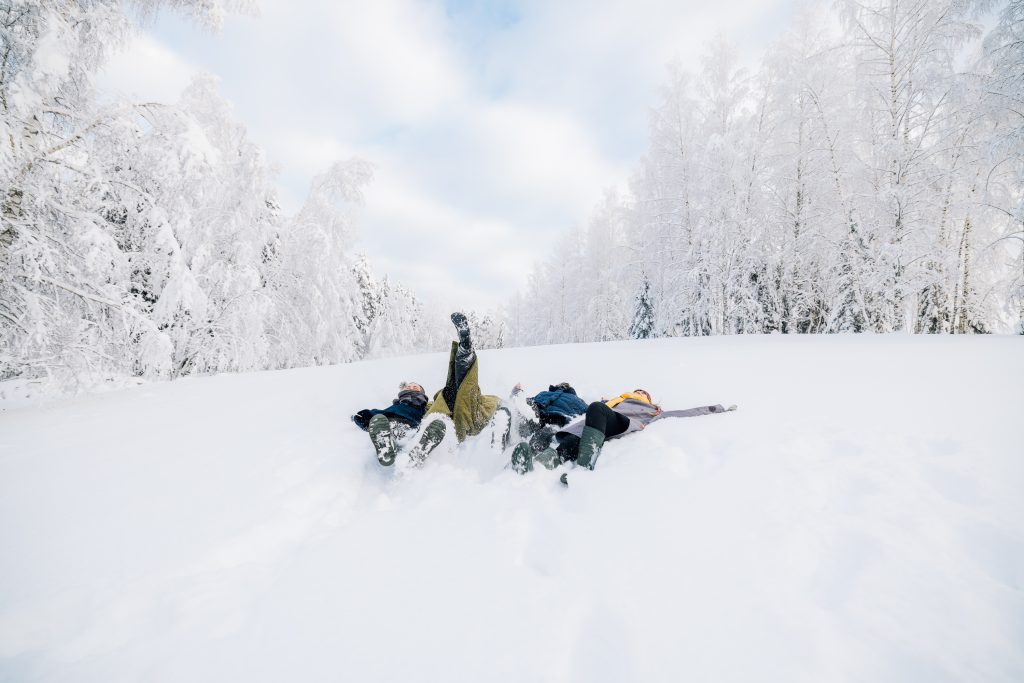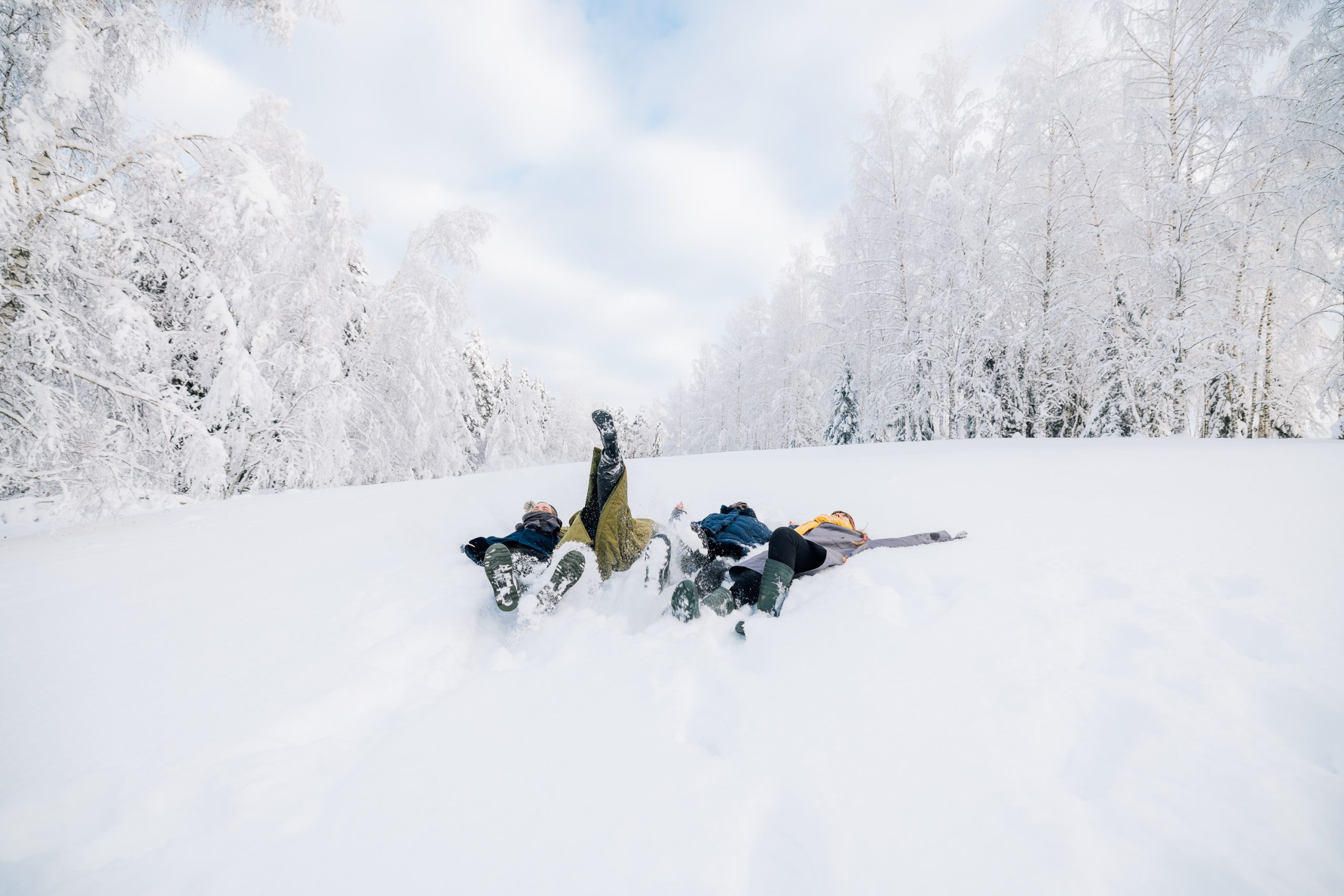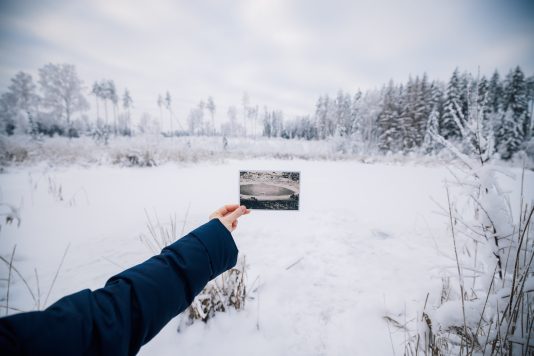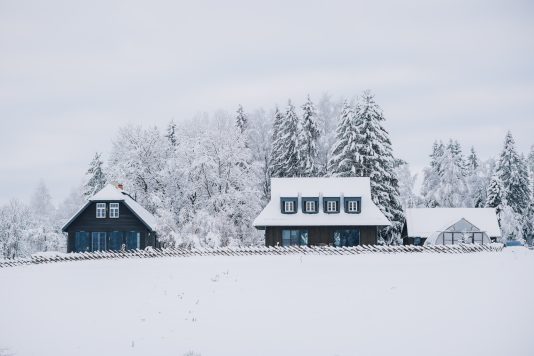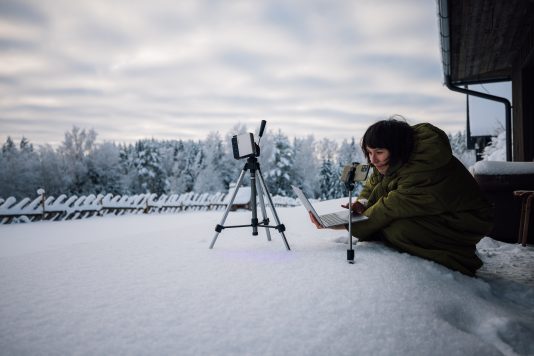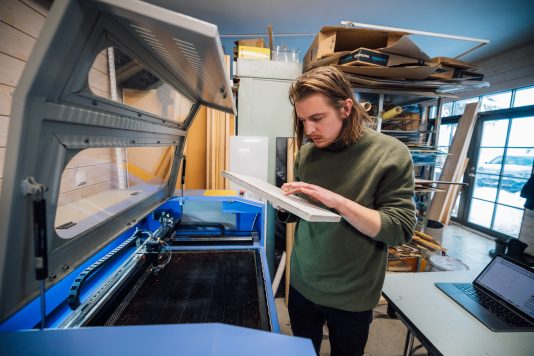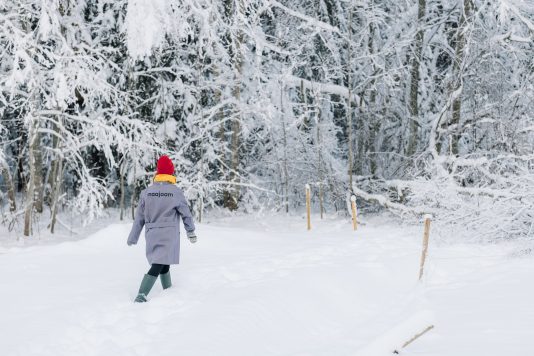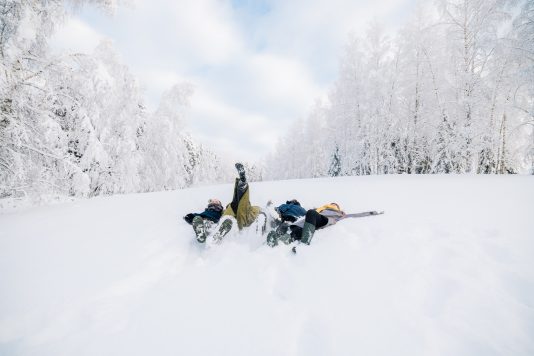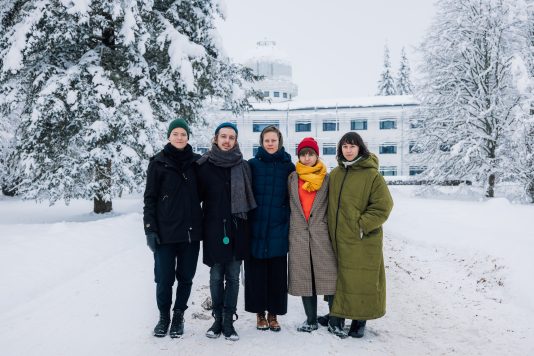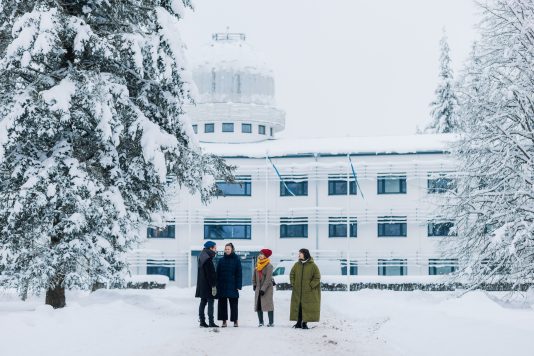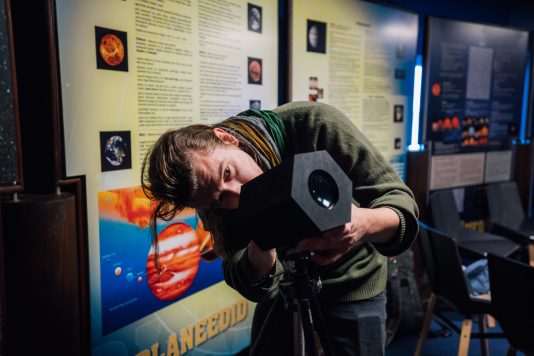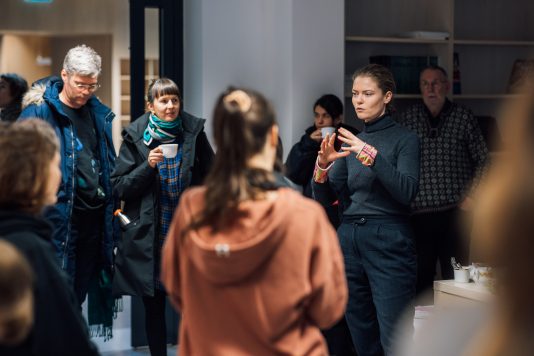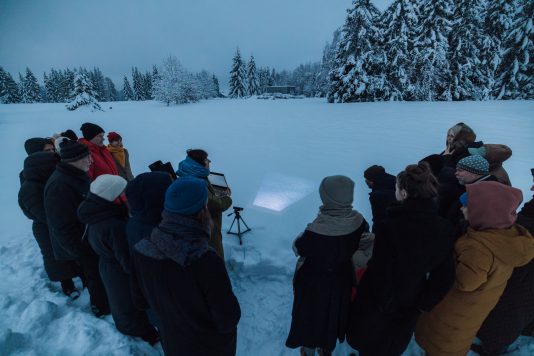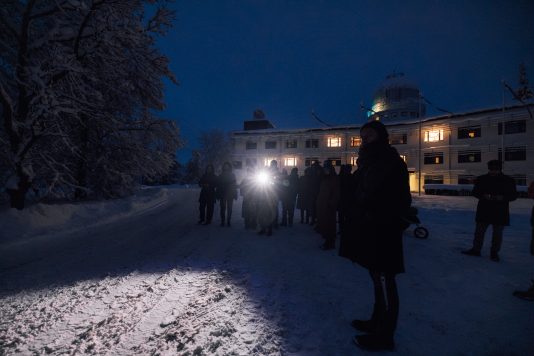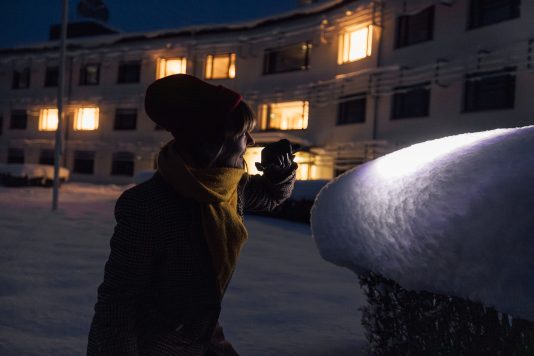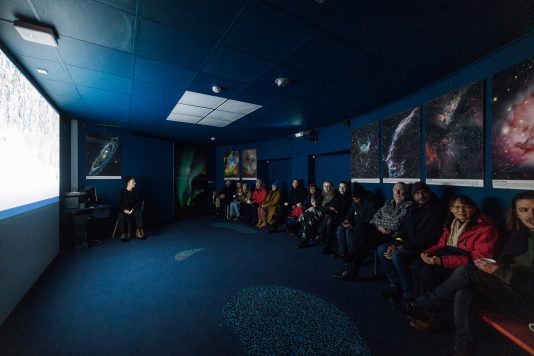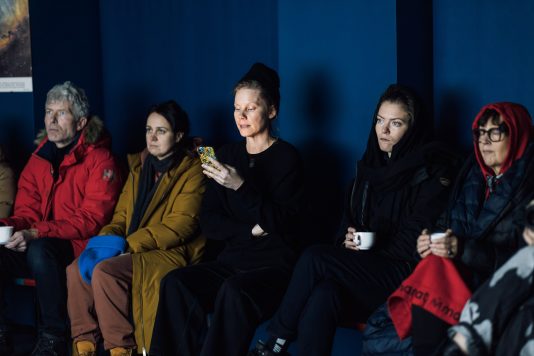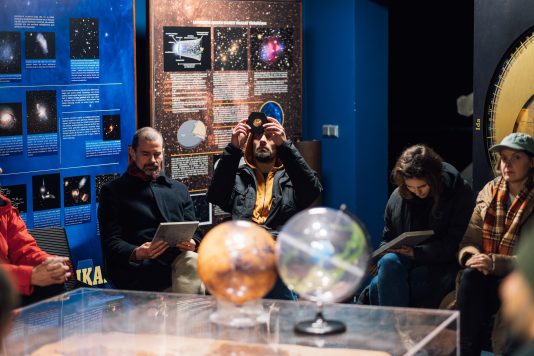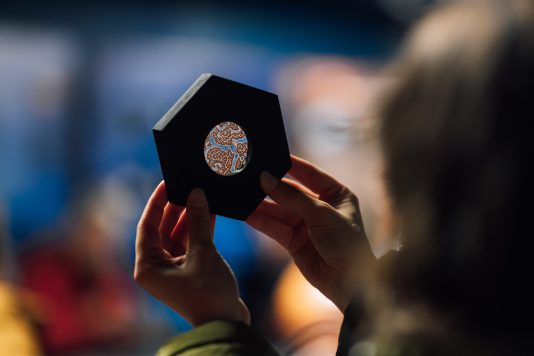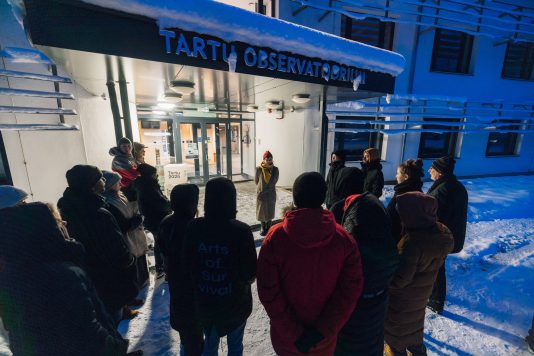Celestial Bodies – Navigating Between Scientific Knowledge and Indigenous Wisdom
Hosted for residence in Tartu Observatory in Tõravere / Estonian Space Centre, 2023
Artists-in-residency: Eglė Šimėnaitė, Juss Heinsalu, Marit Mihklepp, Piibe Kolka
Sitting in the grass with my daughter, solar eclipse glasses covering our eyes as we watched the moon pass between the earth and the sun, changing the tone of the world just then. An alignment that turned time and space into a strange, satisfying kind of enchantment.[1]
The borrowed excerpt from Julietta Singh’s book No Archive Will Restore You gives a glimpse of how she experienced a solar eclipse with her daughter. Witnessing a change of light and feeling a strange, satisfying kind of enchantment somewhat sums up the common ground and approach between the invited artists of the residency Celestial Bodies – Navigating Between Scientific Knowledge and Indigenous Wisdom. Initially thought of as a continuation of last year’s residency, Attending To Liminality – Smoke Sauna Tradition which focused on a regional phenomena offering an immersive bodily learning experience from the intangible of ritualistic cleansing and healing, I pictured how Celestial Bodies, aka heavenly bodies, invites the artists to direct their attention outwards – to the physical entities beyond the Earth’s atmosphere. In retrospect, I can admit the opposite – to comprehend Celestial Bodies that appear to be absurdly far from human perception, made the artists look inwards, resulting in artistic processes connected to geological formulations, childhood memories, one’s own body, or recurring movement of terrestrial light.
The Estonian space centre, opened in 1964 as an important infrastructure of the Soviet Union, became the catalyst of the residency as a significant place in the region. Nowadays, its main task continues to be research and development wherein they train an international community of scientists in astronomy, remote sensing, and space technology. The centre is located on the Tõravere hill, about 20 km southwest of Tartu. The initial observatory, built in the 19th century, is located in the city centre of Tartu and functions now as a museum, known for its connection to the astronomer Friedrich Georg Wilhelm von Struve, who created the meridian arc to determine the shape and size of the globe. This geodetic arc is listed under UNESCO World Heritage, stretching over 2820 km from Hammerfest in Norway to the Black Sea.
The space centre’s community consists of about 100 employees with whom artists stepped into dialogue to learn and get inspired by the scientific data, working methods, and paraphernalia (including the largest telescope in Northern Europe, multiple labs, and black boxes used for simulation). Throughout a four-week time span, the artists met scientists from different departments including Indrek Kolka, Laurits Leedjärv, Shishir Sankhyayan, Maret Einasto, Antti Tamm, Lauri Juhan Liivamägi, Saimoon Islam Quazi, Joel Kuusk, and Viljo Allik.
Parallel to scientific knowledge, the commissioned artwork “Star Map” (1964) by the artist Lagle Israel on the wall of the observatory acted as a reminder of the importance of celestial bodies in the indigenous cultures across the world, including the Finno-Ugric people in Estonia. A mosaic made of over 20,000 sea stones depicts 23 constellations – groups of visible stars forming patterns and outlines, including “Milky Way” and “Polaris.” To learn about how the knowledge of the sky was used to structure daily life, residents went to Tartu to meet the folklorist Andres Kuperjanov, specialized in astronomy, who introduced the classification and differences between folk, paleo-, ethno-, and archeoastronomy. The lecture was followed by a collective revisit to Eda Veeroja, known from last year, who had heated up a smoke sauna in Mooska farm in Võrumaa county.
The residency ended with a public showing on the 15th of December at the observatory wherein the artists presented their process and outcome. Eglė Šimėnaitė is a performance artist who worked with the notion of a blue hour. The work took the shape of a collective meditation / performative installation. Piibe Kolka, who is an experimental filmmaker, has originally grown up at the observatory’s grounds as a daughter of a star scientist. The showing took the shape of a performative lecture where she guided us through the grounds of the space centre combining it with her personal childhood memories. Marit Mihklepp is an artistic researcher who is interested in meteorites. She presented to the audience an experimental video clip transforming a nearby pond into a meteorite crater through speculative storytelling. Juss Heinsalu is a ceramist whose main material and interest lies in the material clay. He ended up introducing us to limestone plates from where he had engraved scientific drawings – therefore bringing together to the same image plain fossils of the earth and the cosmic structures.
The public event triggered a wide range of audience, including the space centre’s scientists as well as the artists from Tartu and elsewhere.
Eglė Šimėnaitė
Aftersky (2023)
Blue Hour Performance; Performative Installation
Projector, time-lapse video, tripod, mobile phone, small tripod, computer, environment, time
Eglė Šimėnaitė is a Lithuanian artist based in Turku, Finland, and Prague, Czech Republic. Her artistic output revolves around the felt. Textures of touch, light, sound, absence, and bodies in space offer her a direct way of exploring humanity and its relationship to the environment, opening new, altered worlds through the senses.
Her starting point at the Celestial Bodies residency was the materiality of ice, which seemed suitable due to the weather conditions of cold and snowy surroundings. Soon after capturing multiple time lapses of different structures made of ice during the twilight, she realized that her actual interest lies in the daily recurring light of the blue hour wherein ice had a secondary role. By the end of the residency, the project Aftersky was born that is a contemplation on the everyday skygazing and the changing color gradient effects of the blue hour. By crossing two different timings – the blue hour of the environment in the present moment of the experience and the blue hour of the previous day displayed in the environment – Eglė is placing the focus on the moment when these two timelines dissolve into one another. To draw a triangle between the three most important parties in a processual experience: time, environment and the observer, she repeatedly follows the colours of the sky from just before dusk to the darkness of the night.
Through participation, the observer is present in only one link of this chain, completing the relationship with their gaze and, at the same time, the triangular processuality of the experience. As we witness the two colours of blue trying to merge into each other, waiting for the collision of these two timelines, we observe the unexpectedly dramatic process of changing colour. It doesn’t matter anymore if the colours meet; the experience of the movement itself makes the crosscut into our time and existence, as we perceive it.
The project leaves a commentary about how we observe the sky: the waiting for the sky to reveal itself for us to witness, the failed attempts to capture ever-changing skyscape, the translation between the vision and our individual perception traveling through linked devices. Aftersky invites us to collectively skygaze into the past and to connect with the out-of-oneself.
Juss Heinsalu
Geostellar Drafting (2023)
Limestone plates (in different sizes: 7×15 / 20×20 / 20×40 / 30×50 cm)
Juss Heinsalu is an Estonian artist based in Tallinn and Halifax, Nova Scotia in Canada. His autonomous research-creation process explores the embodiment of life in clay, merging scientific hypotheses, mythological and ethnographic knowledge with material-based studio practice. The latest work focuses on petrification and speculative conditions that present alternative mineral-based lifeforms.
His exploratory process during the Celestial Bodies residency began by analyzing illustrative charts and data visualizations made by the scientists in Tõravere. That, in turn, led to looking at local limestone plates and experimenting with laser-engraving techniques to draw parallels in ways of mapping and highlighting celestial and geological bodies. A series of material tests (cut limestone in different sizes: 7×15 / 20×20 / 20×40 / 30×50 cm) were produced to understand the limits of the tool and the potential to further work with the stone. This project also included prototyping an optical apparatus (hexagonal casing from plywood 15x13x17 cm and magnifying glasses) for viewing video work (footage recorded with a PXL2000 camera of rotating stones in Summer 2023; video editing in-process) relating to the residency topic.
This residency enabled a shift in the existing view of the previous work (clay slides, ceramic lenses and light projections, etc.) and brought forward new questions about scaling, structures of the universe, deep time, object evolution, astrobiology, fractality, fossilization, and the overall relationship between astronomy and geology.
Marit Mihklepp
wa(l)king the meteorite (2023)
Video, duration: 8min
air stones, sky bones, void holes (2023)
Video projection, real-time voiceover, in English
Marit Mihklepp is an artist and researcher based in The Hague in The Netherlands and Tallinn. She focuses on learning from and relating to the more-than-human bodies and timescales. Her artistic practice develops in attention exercises, sensory field work, respectful gathering, instruction writing, movement research, audiovisual experiments. Marit is currently searching for forms of storytelling beyond human, circling around meteorites, myths and measuring.
She came to the Celestial Bodies residency with an idea to write a script for a new video piece around meteorites. She thought that the astrophysicists would help her to find relevant pieces of information, but it turned out that for them celestial stones become just ordinary stones, once they fall on Earth – therefore, she was told to look for the geologists instead. Marit continued searching for the meteorites in old books but found mostly comets and planets. Then she turned the frozen pond at Maajaam residency centre into a small meteorite crater that began to measure the outline of with her steps. Every step became a minuscule meteorite fall, leaving a crater behind. Every backward step increased the possibility of falling. She tried to hear the meteorite iron in her own blood – speculating if it is possible that the Kaali meteorite that fell 3500 years ago might have given its extraterrestrial iron to a soil body to a potato body to her grandfather’s body to her own body – making us all blood-related.
Searching for something in the wrong place has its own charm, as you are able to find something else. We might not be noticing, but the liquid form of the meteorite is flowing in all our bodies. Perhaps this is the beginning of the script I wanted to write.
Piibe Kolka
left of here, the end of cosmos (2023)
Performative Tour, duration: 30 min, in English
Piibe Kolka is an artist and filmmaker with a background in anthropology. She is interested in artists’ moving image as a personal inquiry into the bodily, temporal and rhythmic aspects of social realities. She works with video, sound, performance and writing. Currently she is involved in artistic research about live cinema.
Piibe worked with personal memory, its physical attributes and a bodily sense of place. While talking to the scientists in Tõravere, she was interested in the contrast between the level of abstraction in their work (working through observation, calculation, simulation, imagination) and the very physical experience of the place that she has had. She was also drawn to the ways how notions of astrophysics enter everyday lives of non-scientists, sometimes becoming metaphors, sometimes parts of bodily experiences.
At the end of the residency, she presented a performative tour taking the audience through the physical space in and around the observatory while illuminating specific locations in the space with a flashlight and describing scenes featuring a child at different ages. The stories are told in present tense and in third person as if projecting a look back in time onto the space for the audience to see and feel. It is a spatial journey that plays with time, focus and imagination. She will continue developing this project. While moving further she is also interested in the way a spatial experience and movement through space can play with filmic or cinematic qualities.
[1] Julietta Singh, No Archive Will Restore You, punctum books, 2018, p. 55.
Curatorial text by Ann Mirjam Vaikla
